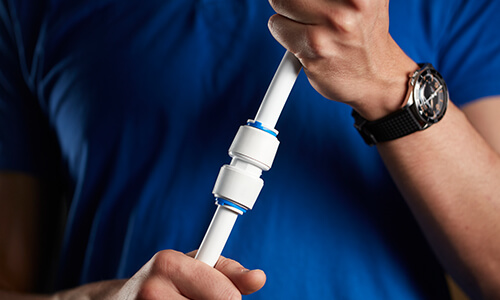Is Push Fit Plumbing Reliable?
As with many more modern and convenient technologies, the reliability of push fit pipes have been disputed by individuals.
There are many myths surrounding the track record of push fit pipes, with a number of people unsure as to whether the couplings can create a secure and permanent seal – after all, logic would determine that pushing two pipes together does not create the same strength as soldering them.
Push fit plumbing systems, however, are incredibly strong and safe to use when installed correctly. Read on to find out some of the most common myths surrounding these systems, and the benefits of push fit pipes that have now disproven these.
Push Fit Plumbing Myths
- “Soldering pipes is a skill, any allowing anyone to use plastic push fit fittings devalues the trade.” - There is still skill in fitting push fit systems - the MOST important skill a professional plumber can have is their knowledge and ability to recommend the best system for each individual application, and if this happens to be push fit, the plumber is not losing a skill, but in fact utilising their most efficient and important one. Similarly, although soldering is a great skill for plumbers to have, the understanding of the system and ability to correctly lock pipes into position is a key skill not to be undermined. First timers often incorrectly lock together their push fit systems, so the value of a professional is never wasted.
- “Plastic push fit fittings can only be used with plastic pipes, so you can’t use them with metal systems.” – Incorrect! Push fit fittings are designed to be used to lock any two pipes together, and these can even be two different materials. Out push fit range is compatible with both copper and brass.
- “Plastic won’t last as long as copper or brass!” – Plastic actually lasts incredibly long, and is not prone to rust like some metal materials. All of our push fit pipes and fittings are WRAS approved, meaning they have been rigorously tested and are proven to be highly durable.
Push Fit Pipe Considerations
 Almost all of the disadvantages and considerations regarding push fit plumbing boil down to incorrect installation. When installed correctly, the system is fast to fit and cost effective due to less labour time being required.
Almost all of the disadvantages and considerations regarding push fit plumbing boil down to incorrect installation. When installed correctly, the system is fast to fit and cost effective due to less labour time being required.
It’s worth noting that plastic pipework cannot be used for gas or oil supply or within the first metre of a gas boiler. Much like copper, specialist tools are required to cut the pipe, so make sure you have these on hand before you begin your installation.
However, should the installation go wrong if it is not pressure and leak checked, or if the pipes are poorly fitted, there is an increased risk of bursting, which can cause large amounts of expensive water damage. Don’t take on the installation yourself if you’re not confident, and ensure that anyone you hire to install your push fit system has the relevant training an insurance.
Benefits of Push Fit Plumbing
Push fit plumbing systems are becoming more and more popular in homes around the UK. They’re quick and easy to install, as well as being incredibly durable. One great benefit of push fit pipes that most people don’t consider is that they’re a brilliant alternative when you cannot use welding or burning methods to join pipes, such as in properties with thatched roofs – of which there are many in the UK!
As well as this key feature, push fit plumbing systems boast a whole host of benefits, such as:
- The installation is much faster due to there being no need to solder or weld pipes together.
- Pipe repairs can be completed much easier – usually just by slipping on a new push fit fitting.
- They can be used as both a permanent and a temporary fix, and the fittings can easily be removed if necessary.
- The variety of sizes makes them suitable for most hot and cold-water applications.
- Plastic is less expensive than copper, and installation is more cost effective due to the quick speed the system takes to fit.
- The pipes are lead free, corrosion free and non-toxic, and less likely to burst in the winter months.
- The pipes and fittings can withstand both heat and pressure. In fact, they’re often tested to standards greater than any required in domestic situations.
- Plastic pipe won’t scale up in areas of hard water, reducing the risk of pipe blockages.
Push Fit Plumbing Installation Tips
There are a few basic tips that can help the installation of your push fit system go smoothly.
- Ensure you have all the tools for the job – nothing would be worse than being caught short halfway through your installation. There is a tool designed to remove certain push fit fittings – it’s worth having this tool for quick removals if you make a mistake, even if your installation is intended as a permanent repair.
- Make sure there are no burrs on the end of the pipe, as this can cause damage to the O-ring and compromise the watertightness of the seal.
- Make sure the Pushfit system you are using is approved for your intended use
- Always follow the manufacturer’s or seller’s directions – for more information, take a look at our guide on how to install push fit plumbing systems.
Our friendly team are always on hand should you need any more advice regarding installation, maintenance or ordering.



